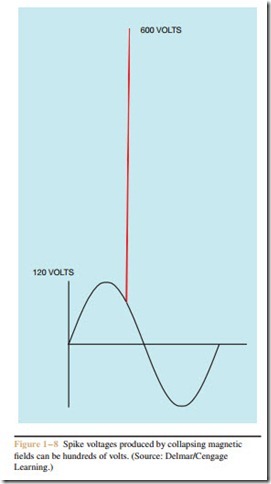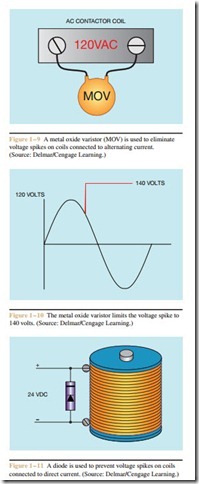Functions of Motor Control
There are some basic functions that motor control systems perform. The ones listed below are by no means the only ones, but are very common. These basic functions will be discussed in greater detail in this text. It is important not only to understand these basic functions of a control system, but also to know how control components are employed to achieve the desired circuit logic.
Starting
Starting the motor is one of the main purposes of a motor control circuit. There are several methods that can be employed, depending on the requirements of the circuit. The simplest method is across-the-line starting. This is accomplished by connecting the motor directly to the power line. There may be situations, however, that require the motor to start at a low speed and accelerate to full speed over some period of time. This is often referred to as ramping. In other situations, it may be necessary to limit the amount of current or torque during starting. Some of these methods will be dis- cussed later in the text.
Stopping
Another function of the control system is to stop the motor. The simplest method is to disconnect the motor from the power line and permit it to coast to a stop. Some conditions, however, may require that the motor be stopped more quickly or that a brake hold a load when the motor is stopped.
Jogging or Inching
Jogging and inching are methods employed to move a motor with short jabs of power. This is generally done to move a motor or load into some desired position. The difference between jogging and inching is that jogging is accomplished by momentarily connecting the motor to full line voltage, and inching is accomplished by momentarily connecting the motor to reduced voltage.
Speed Control
Some control systems require variable speed. There are several ways to accomplish this. One of the most common ways is with variable frequency control for alternating current motors, or by controlling the voltage applied to the armature and fields of a direct current motor. Another method may involve the use of a direct current clutch. These methods will be dis- cussed in more detail later in this text.
Motor and Circuit Protection
One of the major functions of most control systems is to provide protection for both the circuit components and the motor. Fuses and circuit breakers are generally employed for circuit protection, and overload relays are used to protect the motor. The different types of over- load relays will be discussed later.
Surge Protection
Another concern in many control circuits is the voltage spikes or surges produced by collapsing magnetic fields when power to the coil of a relay or contactor is turned off. These collapsing magnetic fields can induce voltage spikes that are hundreds of volts (Figure 1–8). These high voltage surges can damage electronic components connected to the power line. Volt- age spikes are of greatest concern in control systems that employ computer controlled devices such as programmable logic controllers and measuring instruments used to sense temperature, pressure, and so on. Coils connected to alternating current often have a metal oxide varistor (MOV) connected across the coil (Figure 1–9). Metal oxide varistors are voltage sensitive resistors. They have the ability to change their resistance value in accord with the amount of voltage applied to them. The MOV will have a voltage rating greater than that of the coil it is connected across. An MOV connected across a coil intended to operate on 120 volts, for example, will have a rating of about 140 volts. As long as the voltage applied to the MOV is below its voltage rating, it will exhibit an extremely high amount of resistance, generally several million ohms. The current flow through the MOV is called leakage current and is so small that it does not affect the operation of the circuit.
If the voltage across the coil should become greater than the voltage rating of the MOV, the resistance of the MOV will suddenly change to a very low value, generally in the range of 2 or 3 ohms. This effectively short-circuits the coil and prevents the voltage from be- coming any higher than the voltage rating of the MOV
(Figure 1–10). Metal oxide varistors change resistance value very quickly, generally in the range of 3 to 10 nanoseconds. When the circuit voltage drops below the voltage rating of the MOV, it will return to its high resistance value. The energy of the voltage spike is dissipated as heat by the MOV.
Diodes are used to suppress the voltage spikes produced by coils that operate on direct current. The diode is connected reverse bias to the voltage connected to the coil (see Figure 1–11). During normal operation, the diode blocks the flow of current, permitting all the circuit current to flow through the coil. When the
power is disconnected, the magnetic field around the coil collapses and induces a voltage into the coil. Since the induced voltage is opposite in polarity to the applied voltage (Lenz’s Law), the induced voltage causes the diode to become forward biased. A silicon diode exhibits a forward voltage drop of approximately volt. This limits the induced voltage to a value of about 0.7 volt. The energy of the voltage spike is dissipated as heat by the diode.
Safety
Probably the most important function of any con- trol system is to provide protection for the operator or persons that may be in the vicinity of the machine. These protections will vary from one type of machine to another depending on the specific function of the machine. Many machines are provided with both mechanical and electrical safeguards.
Review Questions
1. When installing a motor control system, list four major factors to consider concerning the power system.
2. Where is the best place to look to find specific information about a motor, such as horsepower, voltage, full load current, service factor, and full load speed?
3. Is the National Electrical Code a law?
4. Explain the difference between manual control, semiautomatic control, and automatic control.
5. What is the simplest of all starting methods for a motor?
6. Explain the difference between jogging and inching.
7. What is the most common method of controlling the speed of an alternating current motor?
8. What agency requires employers to provide a workplace free of recognized hazards for its employees?
9. What is meant by the term ramping?
10. What is the most important function of any control system?

